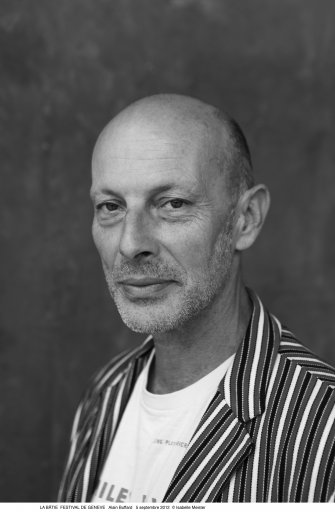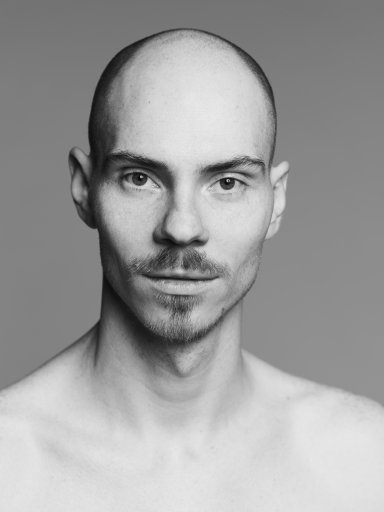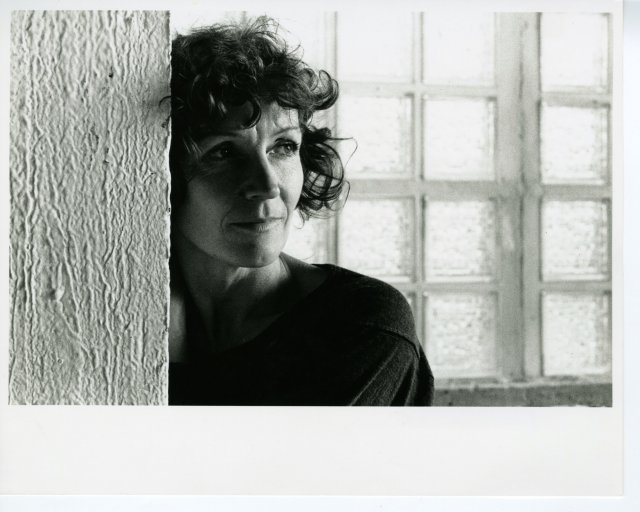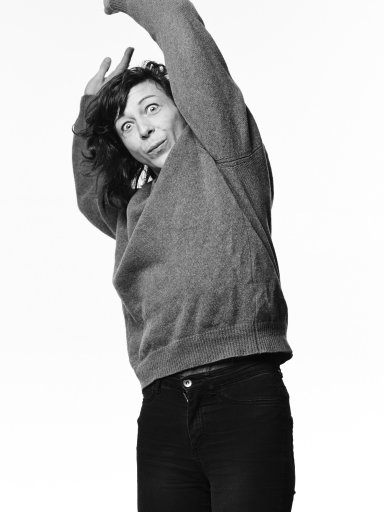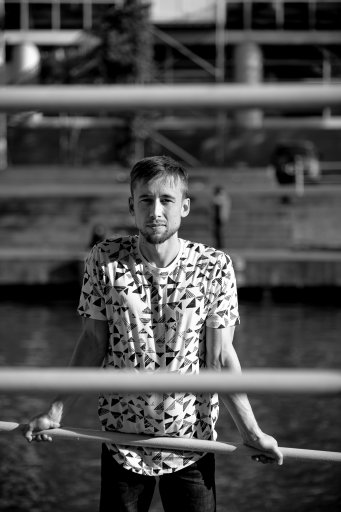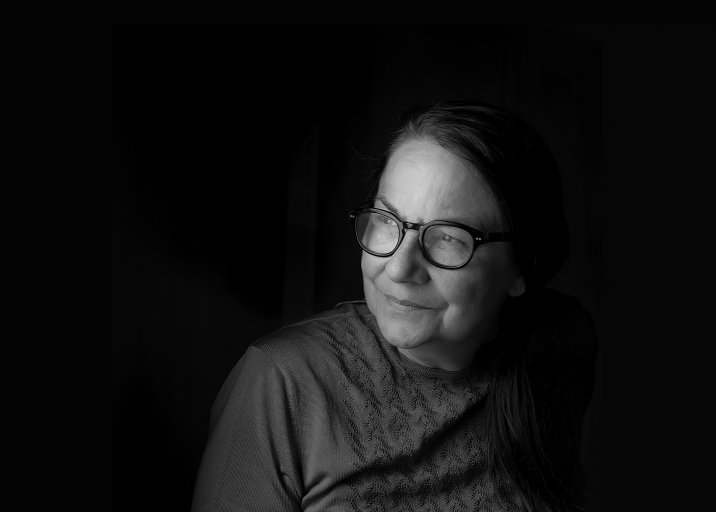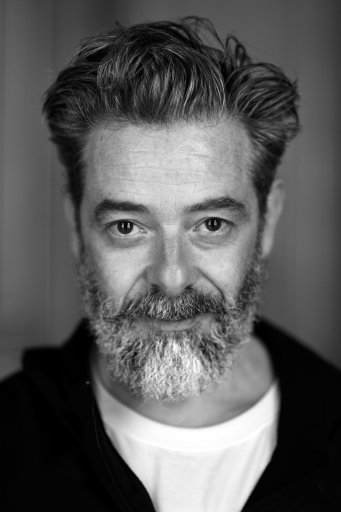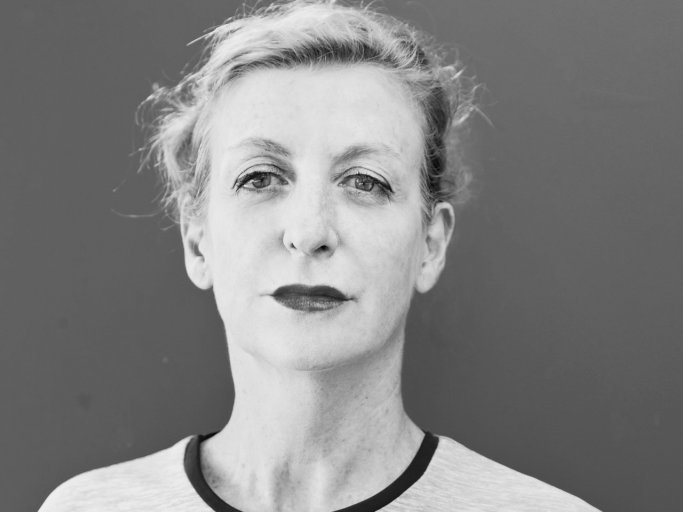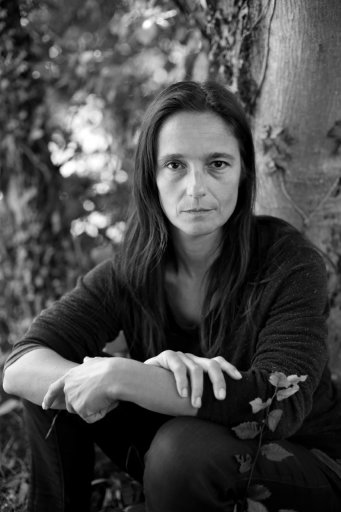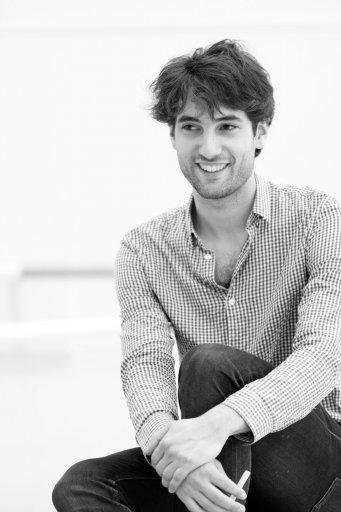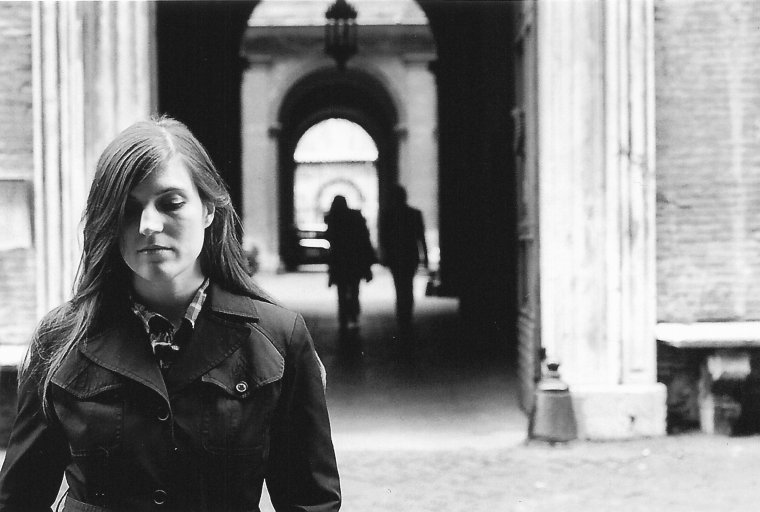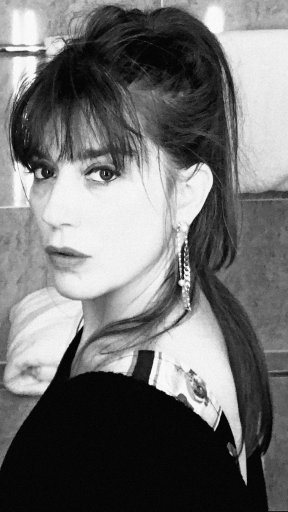Created and put together by the Cinémathèque de la Danse, these half-hour montages presenting an artist from a particular angle are available on request from the Pôle Diffusion team.
Alain Buffard, les théâtres du moi
2017
30 min.
Trailer
Since Good Boy, his first solo work, or the first that counted, Alain Buffard has been exploring his own body, its strengths and weaknesses, its powers and frailties. Subsequently, he continually invented occasionally theatrical productions that would help him to reflect on what underpins and creates a troubled and perhaps trembling identity (the trembling figure is one that often recurs in his work). Masks, T-shirts, wigs, polystyrene costumes, high-heeled compensation shoes, fragmented bodies: the works of Buffard, of MORE et encore à Wall Dancin’ – Wall Fuckin’, invent a new grammar of identity: what is it that makes us resemble someone else, and how can we go from one genre to another, from one face to another, and how can these incessant movements find a community?
Extracts
Les Inconsolés (2005), direction Alain Buffard & Rémy Yadan, 2006
MORE et encore, direction Sophie Laly, 1999
INtime / EXtime, direction Sophie Laly, 1999
My Lunch with Anna, direction Alain Buffard, 2005
Good Boy (1998), direction Vasco Riobom for the Fondation Serralves – Porto, 2003
Wall Dancin’ – Wall Fuckin’, direction Sophie Laly, 2003
Dispositifs 3.1, direction Christophe Bargues, 2001
Mauvais genre (2003), direction Sophie Laly, 2004
With the authorization of Fanny de Chaillé, légataire de l’œuvre d’Alain Buffard,
PI:ES, et le Centre national d’art et de culture Georges Pompidou
Fanny de Chaillé, being offbeat
2018
30 min.
Trailer
In Fanny de Chaillé’s work, there is always a moment which can be comic, or even totally burlesque, when things we thought to be stable waver or drift off course: you bump straight into doors, you stumble and fall, you watch your own shadow live out its life in front of you, you speak without opening your mouth, you fail to make yourself understood. In the end, everything in this work is a question of rhythm. Not the right rhythm, not at the right moment, not with the right words, nor in the right order. By artfully playing on a full palette of shifts (the camera can even film off-centre), Fanny de Chaillé invents a dance-theatre that touches on the bitter-sweetness of the greatest difficulties in life. In the end, it is hard to leap calmly into a current of language or gestures and allow yourself to slip gently inside.
Extracts
Karaokurt, 1996
Underwear (solo), 2007
Passage à l’acte, 2011
CHUT, 2015
Ta ta ta, 2005
Mmeellooddyy Nneellssoonn, 2012
Je suis un metteur en scène japonais, 2011
LE GROUPE, 2014
Les Grands, 2017
Underwear, pour une politique du défilé, 2003
Gonzo conference, 2007
Wake-up, concert pour 55 réveils préparés, 2003
Lucinda Childs, getting going
2017
30 min.
Trailer
The art of Lucinda Childs could be described as the story of a choreographer who amplifies her movements little by little. In her first performances, she played on the gestures that society allots, not always kindly, to women: making sandwiches (Carnation) or taking a bath with elegant legs (Pastime). Then, gradually, she got going by standing up as a militant claiming her autonomy, who only wants to live and dance in a world whose laws she defines herself. Mathematical abstraction and geometrical compositions are a neutral world in which Lucinda Childs has succeeded in becoming a mistress of forms and durations (Melody Excerpt). Based on this knowhow, she was able to return to the world of classical ballet: arabesques and ports de bras then became complex-free parts of her splendid combinatorics.
Extracts
Carnation (1964), direction Bob Lockyer, 1990
Pastime (1963), direction Marie-Hélène Rebois, 2016
Reclining Rondo (1975), direction CN D, 2016
Calico Mingling, direction Babette Mangolte, 1973
Radial Courses (1976), direction CN D, 2016
Melody Excerpt (1973), direction Jorge Cousineau (film et animation), 2013
Katema, direction Renato Berta, 1978
Einstein on the Beach, An Opera in Four Acts, direction Jack Moore, 1976
Dance (1979), direction Marie-Hélène Rebois, 2014
Kilar, direction Introdans, 2013
With the authorization of Lucinda Childs, Babette Mangolte, Marie-Hélène Rebois, Bob Lockyer, Renato Berta, Daphnie-Production, Pomegranate Arts, Introdans, The Center for the Art of Performance at UCLA, The Pew Center for Arts & Heritage.
The video of Melody Excerpt (animation et film) was commissionned by The Pew Center for Arts & Heritage to be a part of it onlign program A Steady Pulse: Restaging Lucinda Childs, 1963-78. available here
Volmir Cordeiro, Panoplies
2018
15 min.
Trailer
There is always a moment in Volmir Cordeiro’s pieces – which are above all, for the moment in his young career, solos or quasi-solos – where clothing takes on its full significance. For example, he dances in a loose black tunic that hides nothing, he pulls down his tights and pulls them back on, he wraps himself in colourful fabrics or he sticks two pieces of black sticky tape over his eyes. What purpose does this panoply serve? It no doubt shows that perception follows conventions – social as well as with regard to clothing – and that what he is trying to dance, with his huge limbs that slice through and disrupt space, is a form of dance that deconstructs the gaze and accepted norms.
Extracts
Ciel, direction Margaux Vendassi, 2012
Inês, direction Margaux Vendassi, 2014
Pièce de Cœur, choregraphy Volmir Cordeiro & Cristina Moura, direction
Joaquim Pieri, 2012
Époque, choregraphy Volmir Cordeiro & Marcela Santander Corvalán,
direction Margaux Vendassi, 2015
Rue, direction Margaux Vendassi, 2015
L’œil la bouche et le reste, direction Margaux Vendassi, 2017
With the authorization of Volmir Cordeiro, Margelles, Joaquim Pieri.
Odile Duboc, fluidité
2019
30 min.
Extracts
trois boléros – troisième version, direction Jean-Michel Plouchard, 1996
Vol d’oiseaux, direction Danse à Aix, 1981
Insurrection, directionMaison de la culture de Grenoble, 1989
Projet de la matière, 1993
Rien ne laisse présager de l’état de l’eau, realisation Pascal Paul, Vincent Bidault,
Laszlo Horvath, 2005
À la suite…, direction Stéphane Bloch, 1999
trio 03 (deux extraits), direction Yves Dalmau, 2003
Pour mémoire (deux extraits), direction César Vayssié, 1993
trois boléros – première version, direction Jean-Michel Plouchard, 1996
O.D.I.L, direction Laszlo Horvath, 2006
With the authorization of Françoise Michel.
Lisbeth Gruwez, de l’endurance
2019
30 min.
Trailer
Since she started writing her own choreographies, after being a talisman performer during the great years of Flemish dance, in particular with Jan Fabre, Lisbeth Gruwez has pressed on into the same zone: the exhaustion of gestures, the endurance of movements. Everything must persist and resist. Whether it be with hilarious jerks (AH/HA), an undulating torso (Lisbeth Gruwez dances Bob Dylan) or the backwash of a wave (The Sea Within), the point is always to push movement beyond what is reasonable, as far hypnosis and, perhaps, trance. The bodies — both those of the performers and the spectators — struggle with fatigue, then get their respiration back, to breathe just so as to endure such a harsh duration.
Extracts
L’Origine, direction Kris Kenis, 2011
It’s Going to Get Worse and Worse and Worse, My Friend, direction Voetvolk vzw, 2012
Lisbeth Gruwez Dances Bob Dylan, direction Voetvolk vzw, 2015
The Sea Within, direction Voetvolk vzw, 2018
Ah/Ha, direction Voetvolk vzw, 2014
We’re Pretty Fucking Far From Okay, direction Voetvolk vzw, 2016
Penelope, direction Voetvolk vzw, 2017
With the authorization of Lisbeth Gruwez, Maarten Van Cauwenberghe, Voetvolk.
Daniel Linehan, rythme et langage
2019
15 min.
Trailer
How to sum up Daniel Linehan? Rhythm and language. For this American choreographer, based in Brussels s, what is evocative about us is what gives meaning and rapidity to our gestures. Sometimes these are just murmurs, decomposed syllables or groans (Digested Noise) and sometimes phrases by Hugo Ball or Plato. Sometimes, it is a constantly repeated sentence (Not About Everything) and, other times, words which the dancers shake up to the rhythm of lights that go on / go out. But, each time, language is the place where gestures discover a reason to be born and to invent subtle discourses full of retakes and interruptions.
Extracts
The Karaoke Dialogues, direction Kaaitheater, Bruxelles, 2014
Zombie Aporia (2011), direction STUK, Louvain, 2015
Not About Everything (2007), direction Singel, Anvers, 2017
Un Sacre du printemps, direction Opéra de Lille, 2015
dbddbb (2015), direction Kaaitheater, Bruxelles, 2016
Flood, direction Kaaitheater, Bruxelles, 2017
With the authorization of HIATUS, Daniel Linehan.
Maguy Marin, ou comment dire
30 min.
Trailer
Not only does Maguy Marin dance with bodies. She also dances with sounds, onomatopoeia, words, phrases, foreign languages, language in general. From her earliest works, words have always been not only material but also one of the key driving forces of movement, a sort of rhythmic rule more or less hidden, as demonstrated by the famous Fini. C’est fini. Ça va finir. Ça va peut-être finir, taken from Beckett, and which offers a rhythmic unit to the compositions of May B. But between the very simple frightened “Ah’s” and surprised “Oh’s” (Ramdam) that give the dancers impetus and phrases in Latin from Lucretius that immobilise them (Turba), there are, it is true, a hundred ways of using language, as Maguy Marin joyfully proves.
A dancer and choreographer, Maguy Marin, born in Toulouse, studied classical dance at the Conservatoire de Toulouse then entered the Ballet de Strasbourg, before joining Mudra, Maurice Béjart’s multi-disciplinary school in Brussels. In 1978, with Daniel Ambash she created the Ballet-Théâtre de l’Arche, which became the Compagnie Maguy Marin in 1984. The Centre Chorégraphique National de Créteil et du Val-de-Marne was created in 1985, a hub of intense work that was disseminated throughout the world. In 1987, the encounter with the musician and composer Denis Mariotte led to a long collaboration. In 1998, the Centre Chorégraphique National moved to Rillieux-la-Pape. An “us in time and place” that reinforces our ability to bring out “these diagonal forces that resist forgetting” (Hannah Arendt). In 2011, she re-evaluated the methods used by the company for its reflection and practice. In 2012, after the intensity of the years spent at the CCN in Rillieux-la-Pape, a need was felt for a new stage rooted in the city of Toulouse. In January 2015, Maguy Marin and the company returned to Lyon. Their work at Ramdam in Sainte-Foy-lès-Lyon saw the creation of an ambitious new project: Ramdam, an art centre.
Extracts
Ramdam (1995), direction Luc Riolon, 1997
May B, direction Luc Riolon et Charles Picq, 1981
Babel Babel, conception Olivier Morel, Ariane Le Couteur, Hugues de Rosière, 1982
Aujourd’hui peut-être, realisation Luc Riolon, 1996
Ha ! Ha !, direction Charles Picq, 2006
Pour ainsi dire, direction Luc Riolon, 1999
Waterzooï (1993), direction Luc Riolon, 1994
Quoi qu’il en soit, direction Luc Riolon, 1999
Nocturnes, conception Maguy Marin et Denis Mariotte, direction David Mambouch, 2012
Description d’un combat, direction Charles Picq, 2009
Turba, design Maguy Marin et Denis Mariotte, direction Charles Picq, 2007
With the authorization of Maguy Marin, Cie Maguy Marin, Luc Riolon, 24 Images,
Maison de la Danse, L’envol Productions.
Solitude(s) de Mathilde Monnier
30 min.
Trailer
Mathilde Monnier’s dance is imbued with the theme of solitude. Although there are many dancers on stage in her works, each dancer is detached through his individuality and the way he finds his place in the group or solo. In Tempo 76, a work given rhythm by unison, obeying the metronome of Ligeti’s music, each dancer is both a common body and a single body. In Déroute, the performers follow their paths on the same floor, meeting or passing each other by chance according to their progression. Les Lieux de là, also, in its way, recounts the story of the dispersal of a community that is endlessly reconfiguring itself. Duos and trios—linking figures—are frequent in Mathilde Monnier’s grammar, but what dominates are solitary dancers, true solos or several solos (see the rock wanderings of Publique), where each man or woman allows themselves to be led by their own movement and their own waywardness.
Extracts
Soapéra, direction Karim Zeriahen, 2010
Les Lieux de là, direction Valérie Urréa, 1998
Pour Antigone, direction Valérie Urréa, 1993
Tempo 76, direction Valérie Urréa, 2007
Publique, direction Valérie Urréa, 2004
Pavlova 3’23’’, direction Karim Zeriahen, 2009
Chinoiseries, direction Valérie Urréa, 1991
MM in Motion, direction Vivian Ostrovsky, 1992
2008 vallée, direction Valérie Urréa, 2006
Déroutes, direction Valérie Urréa, 2002
With the authorization of Mathilde Monnier, Association MM, Dominique Figarella,
Philippe Katerine, Wisdom Films, Artline Films, On The Fly Productions.
Christian Rizzo, mortellement
2017
30 min.
Trailer
In the work of Christian Rizzo, the stage is nearly always dark, circumscribed by night, darkness, the fear of darkness and nasty rabbits (b.c., janvier 1545, Fontainebleau). Death is constantly on the horizon in his pieces. But it is not always frightening. Sometimes, of course, it resembles the hanged (Le Bénéfice du doute) or a motorcyclist in a helmet who brings to mind the films of Cocteau (Comme crâne, comme culte), but at other times it is also as gentle as two ghostly dresses that dance in the breeze from fans (100% Polyester). Gentle or cruel, however, it is death that endlessly roams, surrounds, consoles or petrifies, making the dancers cry out or fall (Soit le puits . . .), with threats to immobilize them in frozen poses. Rizzo’s dance is a dance with or against death, where each movement is ultimately a joyous sign of survival.
Extracts
Soit le puits était profond, soit ils tombaient très lentement, car ils eurent le temps de regarder tout autour, direction Sophie Laly, 2005
D’après une histoire vraie, direction Sophie Laly, 2013
Le Bénéfice du doute, direction Sophie Laly, 2012
Le Syndrome Ian, direction Sophie Laly, 2016
b.c, janvier 1545, fontainebleau, direction Cinémathèque de la danse, 2007
Sakınan göze çöp batar, realisation Sophie Laly, 2012
Comme crâne, comme culte, 2005
Et pourquoi pas : “bodymakers”, “falbalas”, “bazaar”, etc, etc… ?, realisation Jean-Gabriel Périot, 2001
Fom 1, direction Christian Rizzo et Iuan-Hau Chiang, 2009-2011
100% polyester, objet dansant n o (à définir), direction Sophie Laly, 1999
With the authorization of Christian Rizzo, ICI – Centre chorégraphique national de Montpellier – Occitanie.
Ana Rita Teodoro: animal body, vegetal body
2018, 15 min.
Trailer
Ana Rita Teodoro creeps like a worm or a snake through the streets of Lisbon. She picks up papers between her legs like a busy spider. She slowly undulates her arms, like supple seaweed at the bottom of an aquarium. She glides over another body in a strange simulation of love. In the dance of this young Portuguese choreographer there is a feeling of both animality and vegetation, a wilful exploration of the frontiers of the human body; hence the title Orifice, which is often a generic term for her. Ana Rita Teodoro moves along the edges of spaces. The idea of such dancing is to feel what a body can learn by mingling, temporarily, with another nature, or other forms of gesturing, and above all an organicity which is utterly different, which givess the body a strange and appealing way to inhabit space and time.
Extracts
MelTe (2009), direction Alex Campos Garcia, 2012
Plateau, collection Délirer l’Anatomie (2017), realisation Ana Amorim, 2018
Rêve d’intestin, collection Délirer l’Anatomie (2015), direction Ana Amorim, 2018
Fantôme méchant (2013), direction Pedro Moura, 2015
Orifice Paradis, collection Délirer l’Anatomie, direction CNDC d’Angers,
Tidiani N’Diaye, 2012
With the authorization of Ana Rita Teodoro, Fondation Serralves and CNDC d'Angers.
La Ribot, or the duration of the gesture
2018
30 min.
Trailer
The frequent nudity in La Ribot’s work hides something. Something different, and something moreover that is well worth looking at. First of all, La Ribot loves to experiment with duration, which she stretches out as much as possible – sometimes for hours, as in Laughing Hole, where the female dancers exhaust themselves laughing. In addition, she is not afraid to return to the simplest gestures and repeat them endlessly, very often subverting classical grammar, as demonstrated by the almost comical and highly energetic chorus lines of PARAdistinguidas. Duration and repetition are part of a more general project based on hypnosis or fascination, of which the minimalist trio Another Distinguée is a magnificent example. The aim is to alter the viewer’s perception, to give them a chance to inhabit another time and another place, a space where expectations collapse, where there is nothing to generate other than the very naked feeling of being there.
Extracts
Muriéndose la sirena, Pièce distinguée n°1 (1993) / Treintaycuatropiècesdistingué&onestriptease 1991-2003, direction de Luc Peter, 2003
N°14, Pièce distinguée n°14 (1997) / Distinguished Hits 1991-2001, direction du Centre national de la Danse, 2016
Desasosiego, Pièce distinguée n°52 (2016) / Another Distinguée, direction du Collectif des routes, 2016
Gustavia (2008), conception de La Ribot et Mathilde Monnier, direction de Luc Peter, 2009
Forex, Pièce distinguée n°44 (2011) / PARAdistinguidas, 2011
40 Espontáneos (2004), direction de Jean-Yves Varin, 2004
EEEXEEECUUUUTIOOOOONS !!! (2012), direction du CCN-Ballet de Lorraine, 2012
Laughing Hole (2006), direction de Luc Peter, 2009
19 equilibrios y un largo, Pièce distinguée n°19 (1997) / Distinguished Hits 1991-2001, direction du Centre national de la Danse, 2016
Sans titre IV, Pièce distinguée n°17 (1997) / Treintaycuatropiècesdistingué&onestriptease 1991-2003, direction de Luc Peter, 2003
Noé Soulier, écriture sur écriture
2017
15 min.
Trailer
Writing is a recurring theme in Noé Soulier’s work, whether he is commenting on and explaining out loud his own dancing while he is doing it, or whether he is writing precise phrases that dancers appropriate in their own way, starting and ending them where they want. Each time he reflects on what writing can contribute to dance. It is no doubt Noé Soulier’s belief in the richness of choreography that makes the avenue he has started to explore so unique.
Extracts
Hand Catching Signs, 2013
Mouvement sur mouvement, direction Jérôme Fino, 2013
Le Royaume des Ombres (2009), direction Kaaitheater-Bruxelles, 2010
Petites perceptions, direction Kaaitheater-Bruxelles, 2010
Removing (2015), direction du TAP Poitiers, 2016
Movement materials, direction Antoine Pierlot, 2014
Signe blanc, 2012
Faits et gestes, direction Sophie Laly, 2016
With the authorization of Noé Soulier, ND Productions, Fondation Louis Vuitton.
Asha Thomas, de l’énergie
2020
30 min.
Extracts
Du désir d’horizons, 2018
Eikon, 2011
FIX ME, 2018
Héroïne, 2015
Ghazals, 2012
CLAY, 2014
Cindy Van Acker, géométriquement nôtre
2020
30 min.
Extracts
Obvie, 2015
Nixe, 2015
Obtus, 2015
Monoloog, 2010
Drift, 2013
Zaoum, 2016
Diffraction, 2011
Speechless Voices, 2016
Magnitude, 2013
Anechoic, 2014
Gisèle Vienne, le suspens
2019, 30 min.
Trailer
Gisèle Vienne’s dance seems never to give up on narrating something — even if it’s not always clear exactly what. Perhaps nothing specific at all, perhaps just the simple feeling of there being a story. What matters above all is the construction of effects of suspense and suspension to say that we (spectators, humans) have been caught up in a tale that transcends us and could aggress us at any moment (as in the gory prose of Dennis Cooper, the choreographer’s regular collaborator). Puppets, skaters, clubbers: each of Gisèle Vienne’s characters is trapped on the horizon of a threatening world. Blows, injuries, death: the worst is almost always certain, in fact look, it’s coming, it’s here.
Extracts
Last Spring : A Prequel, direction Stéphane Nota, 2012
Jerk, 2008, realisation Antoine Parouty, 2008
The Ventriloquists Convention, direction Patric Chiha, 2015
I apologize, realisation Patric Chiha, 2004
Showroomdummies 2#, direction Stéphane Nota, 2001
This is how you will disappear, direction Stéphane Nota, 2010
Eternelle Idole, direction Stéphane Nota, 2009
Kindertotenlieder, direction Patric Chiha, 2007
The Pyre, direction Stéphane Nota, 2013
Crowd, direction Caroline Detournay et Paulina Pisarek, 2017
With the authorization of Gisèle Vienne, DACM.
Miet Warlop, la désinstallation
2019, 16 min.
Trailer
Plaster and paint, water and plastic, inflatable objects and explosive sculptures, animal bodies and absurd protheses: the world of Miet Warlop, visual-artist performer or performing visual artist, it all depends, often consists in unsettling the world ludically, wildly and often destructively. Paint guns sullying a milky whiteness (Big Bears Cry Too) or exploding chemical solutions, feathers flying everywhere, or a set shattered by blows from a ladder (Mystery Magnet): in any case, the stage space is devoted to attending its own reconfiguration. But this is not a sad apocalypse. On the contrary, it is genuinely creative because the world which has been beaten up by Miet Warlop is actually inviting us into a new balance. In an unsettled world, we can always settle down again.
Extracts
Horse. A Man, A Woman, A Desire for Adventure, realisation Miet Warlop /
Irene Wool vzw, 2017
Dragging the Bone, direction Latitudes Prod (Lille), 2014
Big Bears Cry Too, direction Jan Bosteels, 2018
Mystery Magnet, direction Pascal Poissonnier, 2012
Fruits of Labor, direction Miet Warlop / Irene Wool vzw, 2016
Ghost Writer and the Broken Hand Break, direction Jan Bosteels, 2018
With the authorization of Miet Warlop, Miet Warlop / Irene Wool vzw, Jan Bosteels,
Pascal Poissonnier, Latitudes Prod (Lille).
Métamorphoses de François Chaignaud
2019, 15 min.
All the pieces written by François Chaignaud, most often in collaboration (with Cecilia Bengolea, Nino Laisné, Théo Mercier…) constantly satisfy this principle: you go there to live, sing, dance ‘characters who have no other choice than to transform reality according to their desires’. In other words, male or female they all set their hearts on transcending their conditions such as to produce norm-less bodies that have succeeded in overcoming the categories to which life and the world wanted to assign and limit them. This is a question of gender of course, but not only, not only at all: the contemporary recumbents in Sylphide, or the seventeen François Chaignauds as though coming from Body Double clearly state that, in this work, what needs to be transgressed are limitations.
Extracts
Думи мої – DUMY MOYI, 2013, direction 24 images
Offrande (un portrait de François Chaignaud), 2008, direction Sothean Nhieim
Soufflette, 2018, with Carte blanche, direction Bergen International Festival
Romances incertos, un autre Orlando, 2017, en collaboration avec Nino Laisné, direction Nino Laisné
Radio Vinci Park, 2016 en collaboration avec Théo Mercier, direction Augustin Jacob, Sarah Tchheurekdjan, Claire Rouvillain Sylphides, 2009, with Cecilia Bengolea, realisation CN D
Narcisse, 1905, chorégraphie Isadora Duncan, transmission Élisabeth Schwartz, direction CN D
altered natives’s Say Yes To Another Excess – Twerk, 2012, with Cecilia Bengolea, direction du CN D
Body Double 35, 2017, direction de Brice Dellsperger
With the authorization of François Chaignaud/Vlovajob Pru, Brice Dellsperger, Nino Laisné, Sothean Nhieim, 24 images
